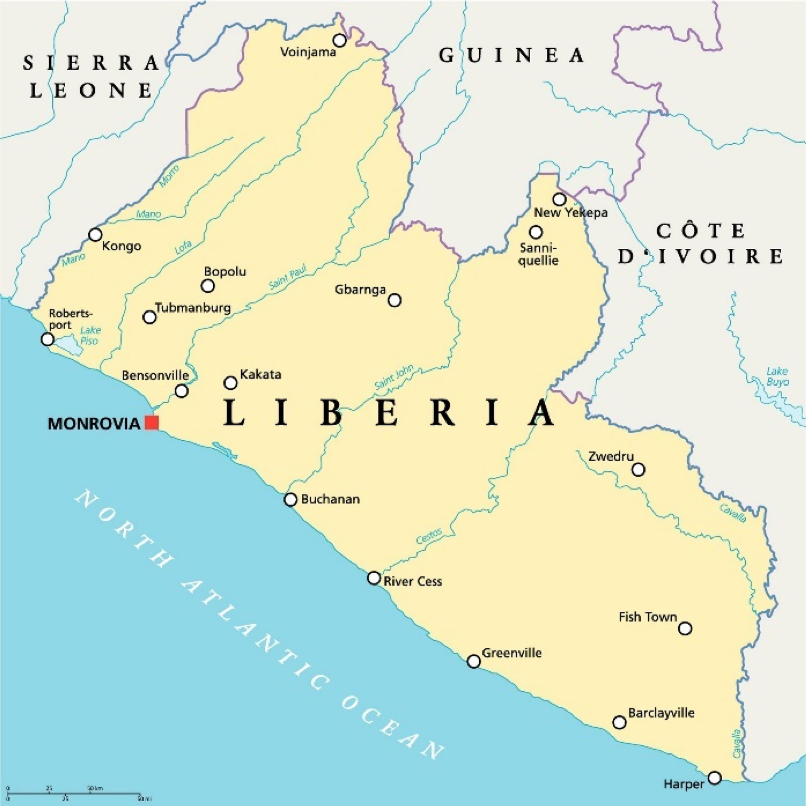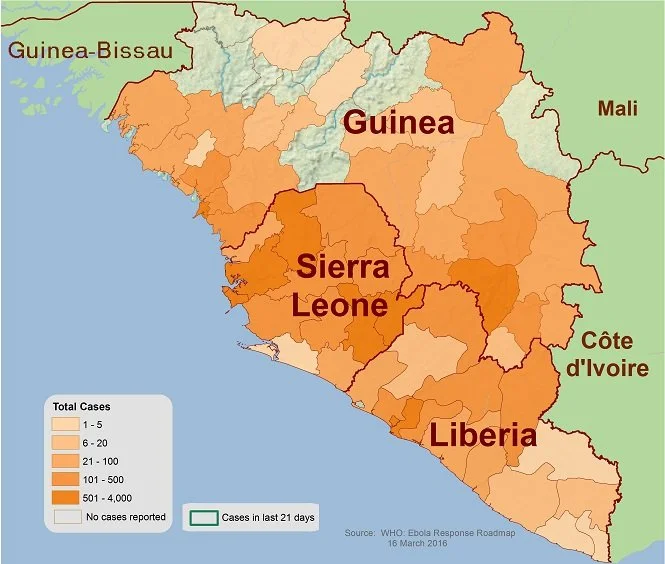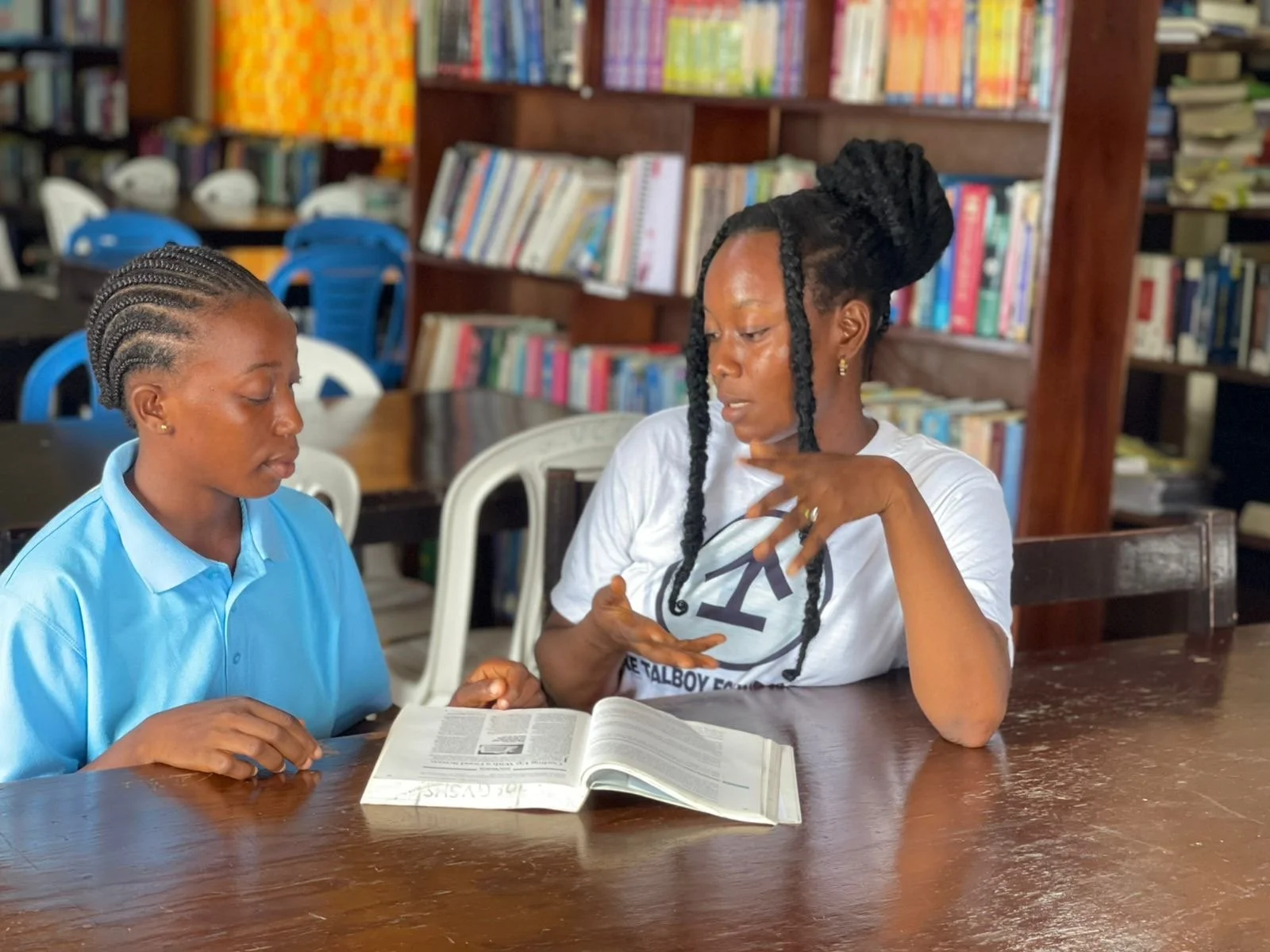Liberia, which means “land of the free,” was founded in 1882 when freed slaves from the United States and West Indies, supported by the American Colonization Society, were allowed to go to Africa.
Monrovia, the capital of Liberia, was named in honor of then President James Monroe. Liberia is located in West Africa and is neighbored by Sierra Leone, Guinea, and Cote d'Ivoire. In 2014, Liberia had an approximate population of 4.5 million persons, of whom 43.2% were children less than 14 years old. The 0–24-year-old population was 61.1%.
As one of Africa’s poorest countries, Liberia’s poverty is rampant, in part as result of two bloody civil wars that destroyed the country’s infrastructure. Massive unemployment has plagued the country, making daily life a struggle to obtain the basics of food, clothing, housing, and health care. The average monthly salary in Liberia is less than $100 USD.
The Talboy Foundation will focus on five major programmatic areas to assist the Liberian people and the nation on the road to recovery after the Ebola virus disease epidemic — education, health, empowerment of women, orphans and children with disabilities, and the Dreams Can Happen Award.
CD Website
EBOLA IN LIBERIA
To exacerbate the already grim economic and development picture of Liberia, during 2014–2016, the largest Ebola epidemic on record hit West Africa, leaving the region, the fragile health care system, and communities in turmoil. West Africa has recorded approximately 30,000 cases of Ebola virus disease 12,000 deaths, with over 5,000 of these cases among children. Liberia alone recorded 10,678 cases and 4,810 deaths.
The most vulnerable persons in emergency situations such as the Ebola epidemic are the children. According to UNICEF, “Some 16,600 children are registered as having lost one or both parents, or their primary caregivers to Ebola in Guinea, Liberia, and Sierra Leone.”2 Many of the children infected with Ebola lost their parents or other family members and were faced with the additional trauma of being placed in an Ebola Treatment Unit, completely isolated from their families. These orphans and child survivors are suffering from Post-Traumatic Stress Disorder (PTSD) as well as still encounter stigmatization from community members and even loved ones. These children will be affected by this crisis throughout their lifetime.
According to an article in the International Business Times,
“One of the challenges Ebola orphans and affected children face is educational support. Many Ebola-affected children live in rural Liberia where it’s difficult to travel to and from school. The orphans also face psychological trauma, for which the Liberian government is providing counseling . . . . There are still more affected children out there and we hope to assist them.”
To see why Ebola ravaged through Liberia and other parts of West Africa causing such pain and suffering, you need to look at the health, economic, and education status that explains why the disease escalated so severely across these three nations.
“Chronic instability has fueled the outbreak in other ways. Few children attended school during the civil wars, and today the majority of adults in Sierra Leone and Liberia have zero education. They cannot read newspapers to learn how Ebola spreads, to understand why—against all emotional tugs—they should force their infected child or partner to die alone from the disease.
“When the last Ebola victim of this outbreak perishes, its effects won’t halt. Hard-won reductions in maternal and infant deaths now appear to be reversing, as health workers devote their energy to Ebola instead of malaria and other maladies. Schools have shut down; the economy is at a standstill. The dying don’t work, and neither do those afraid of infections they may catch on the job or on the bus to the job. If the outbreak continues past December [2015], the World Bank predicts it may cost these three nations $815 million in lost GDP. It’s like war all over again, destroying the foundation countries require for stability.”
EDUCATION IN LIBERIA
Many of the schools in Liberia were destroyed and never rebuilt during the previous civil wars. The average Liberian receives less than 4 years of schooling. Many schools are unable to admit all the children in their communities.
The literacy rate among persons 15–24 years old is 63% for males and 37% for females. The adult literacy rate is the percentage of persons 15 years old and older who can, with understanding, read and write a short, simple statement about their everyday life. Approximately 389,000 children drop out of primary school, of whom 194, 833 are female. Sixty-five percent of children of primary school age are out of school. As of 2014, Liberia had 912,000 pupils enrolled in primary and secondary schools. Of these, 675,000 were in primary school. 5,6
UNICEF estimates that school closures because of the Ebola epidemic affected the education of more than 5 million children. Children who leave school usually do not ever resume their education. Consequently, they are at risk of being involved in exploitative situations, such as child labor.
According to the Liberian Education Profile, the education infrastructure in Liberia is one of the weakest in Sub-Saharan Africa. The region has been unstable politically and socially, and Liberia’s education system is under intense stress. As of 2001, no indications of education exist in Liberia. The access to education has been structural weakness of Liberia.
According to estimates from Liberia’s Ministry of Planning and Economic Affairs, 48% of students are concentrated in primary schools, with 61.41% of those being males and 34.12% females. The dropout rate in Liberia is high, 65% for boys and 73% for girls, with students dropping out before fifth grade. At the secondary level, the net enrollment rate is 34%. The major obstacles Liberia has to fight are parents’ illiteracy, overcrowded classrooms at kindergarten and primary level, high dropout rates, and inadequate educational infrastructure. Moreover, the quality of education is inadequate in Liberia because of a lack of quality curricula, lack of learning materials, lack of qualified teachers, and overall system instability.7
The educational needs of children who survived Ebola and who are unable to afford the cost of an education will be addressed through the Talboy Foundation. The Foundation will provide scholarships to survivors in Liberia and other parts of West Africa through the Mary L. Talboy Memorial Grant by
providing competitive college scholarships to survivors who maintain a B average or higher
providing competitive scholarships to survivors who attend a technical school
providing competitive scholarships to survivors who attend a primary or secondary school
providing books, desks, and other supplies to public and private schools serving populations affected by the Ebola epidemic; and
facilitating sister school programs between schools located in the United States and Liberia.
FUTURE GOAL
The Talboy Foundation will build and operate a school of excellence in Liberia that meets U.S. standards, intended for those students who demonstrate high academic achievement.
TALBOY FOUNDATION LONG-TERM GOALS
Build 20 schools of excellence that meet U.S. standards in other areas of West Africa during the next 20 years.
Partner with universities and international teacher exchange programs to recruit visiting teachers and to facilitate training and certifying Liberian teachers for staffing schools of excellence.
Work with U.S. accreditation agencies to offer dual diplomas to children graduating from a school of excellence, thus ensuring a higher level of learning and opening the doors to graduates attending universities in other countries, including the United States.
TOLL ON THE HEALTH DELIVERY SYSTEM
Health care workers who were on the front lines of caring for victims and survivors experienced a disproportionate number of deaths. In 2015, the World Bank reported on the devastation the Ebola epidemic caused to Liberia’s health system.8 As of May that year, 0.11% of Liberia’s general population had died from Ebola virus disease, compared with 8.07% of its health workers, defined in the study as doctors, nurses, and midwives. This translates to a 10% reduction in doctors in Liberia, which only had about 50 before the epidemic, and an 8% reduction in nurses and midwives. The World Health Organization ranked Liberia, Sierra Leone, and Guinea as 2nd, 5th, and 28th from the bottom, respectively, among 193 countries in terms of doctors per 1,000 people. The Ebola epidemic weakened the already fragile health systems in these countries.
The rate of doctors in Liberia is one doctor per 100,000 persons, compared with the U.S. rate of 242 doctors per 100,000, which translates to only 37 practicing doctors for a country of over 4 million. The disease killed health professionals and drew resources away from other health care challenges, resulting in outbreaks of measles. According to an ABC News article on August 4, 2014,
“The Ebola outbreak left Liberia's fragile health services under extreme pressure. The disease killed health professionals and drew resources away from other healthcare challenges resulting in outbreaks of measles.
“Ebola has run rampant throughout West African countries such as Liberia because the medical situation there is so dire to begin with, according to an American doctor who leads humanitarian missions into the region.
“ ‘The health care system and infrastructure are very poor,’ said Dr. Anne Marie Beddoe, a gynecologist with Mt. Sinai Hospital in New York City. ‘Handling an outbreak of this magnitude only highlights the deficiencies in personnel and equipment.’
“Beddoe said that when she and her husband, Dr. Peter Dottino, who is also a gynecologist, took their first trip to Liberia in 2008, they were shocked to see the state of the medical facilities there. The JFK Medical Center in the capital city of Sinkor, once considered a center of excellence in West Africa, was left outdated and crumbling after withstanding a 30-year civil war.”
In addition to its effect on children and survivors, clearly, Ebola further deteriorated the existing fragile health care system in Liberia. Although the terrifying spread of Ebola captured the world’s attention, it also caused the near collapse of the fragile health care system. Residents began dying of preventable conditions such as malaria, diarrhea, pneumonia, and the effects of high blood pressure and diabetes such as strokes. “If you stub your toe now in Monrovia, you’ll have a hard time getting care, let alone having a heart attack or malaria,” said Sheldon Yett, the Liberia representative for UNICEF. “It is a tremendous threat to children and a tremendous threat to families.”
Children's access to health care has been particularly compromised. Already weak health systems suffered under the strain of the epidemic, which reversed considerable gains made in recent years to curb maternal and child deaths. Nearly a third do not have enough to eat, and one in five children are underweight.11
To assist West Africa, the Talboy Foundation will provide grants for improving the health and psychosocial well-being of Liberians and West Africans through the Glenn E. Talboy, MD, Memorial Grant. Specifically, the Talboy Foundation will focus on
providing grants to maintain community-level psychosocial healing sessions;
providing scholarships to persons seeking an advanced degree in medicine, laboratory science, midwifery, or nursing through an Adopt-a-Doc Program;
facilitating medical missions to Liberia and West Africa; and
providing sustenance to families in need.
Assist with medical payments to persons needing medical attention but who do not seek it because they are unable to pay for it.
Conduct public health educational trainings for public and private clinic staff in conjunction with the Liberian Ministry of Health and Social Welfare (MOHSW).
Assist the Liberian MOHSW as needed during vaccination and other health related campaigns.
Provide grants for building foundation clinics in areas having the greatest need.
TALBOY FOUNDATION LONG-TERM GOALS
Conduct public health educational trainings for public and private clinic staff.
Assist the Ministry of Health and Social Welfare during vaccination campaigns.
Provide additional grants for building foundation clinics in areas of greatest need.
EMPOWERING WOMEN
A research study conducted in selected counties of Liberia reported that approximately 95% of women in the country are single mothers, which gender experts say represents the single most influential gender-based factor in national development because it clearly relates to women’s participation in society and their representation.
“This is based on the fact that, while development and social assessment experts are finding out the problems confronting the African societies, indications are that factors of poverty are many, while its consequences seriously affect our women population, especially the young ladies. After having concentrated on alcoholism and prostitution and the role of youngsters in such habits, here is a picture of how it looks regarding the issue of Single Mothers in Liberia. According to the finding, instead of handling their own share of national development, single mothers are primarily concerned about the survival and upbringing of their children more than community participation, thereby creating a huge gap in development.”
To help women advance and become an integral part of society, the Talboy Foundation will provide grants to women who have lost a spouse and to other women in need so that they can start a small, sustainable business through a Harold L. Shaw Memorial Business Empowerment Grant. The Foundation will also provide scholarships to women and children of single mothers through a Mary L. Talboy Memorial Grant.
ORPHANs AND CHILDREN WITH DISABILITIES
It is estimated that Sierra Leone, Liberia, Guinea, and Cote d'Ivoire are home to more than 1.7 million orphans. Liberia alone was home to 340,000 orphans before the Ebola epidemic, and more than 5,900
Liberian children lost one or both parents to the 2014-2016 Ebola epidemic.
As of May 2015, in West Africa, Ebola has added 16,600 more children who lost at least one parent or caregiver. Additionally, children who are placed in orphanages are released as soon as they turn 18 years old and most do not have the educational background or technical skills to assimilate into society. Many such orphans end up a burden on society.
To help Liberia and other parts of West Africa recover, the Talboy Foundation will provide grants to orphans and children with disabilities, orphanages (particularly those affected by Ebola), and organizations that work with orphanages, orphans, and children with disabilities through the John H. “Casey” Koenig Memorial Grant by providing
scholarships toward a college degree to children and youth who have lost a parent, particularly those residing in an orphanage, who have demonstrated an ability for learning;
a Harold L. Shaw Business Empowerment Grant to start a small business after orphanage support ends at age 18; and
grants to orphanages and other organizations that serve orphans and children with disabilities, to build adaptive and vocational skills necessary for independent living.
The Talboy Foundation is committed to advancing the society as a whole because the road to recovery starts with education, health care, empowerment of women, and caring for those children relegated to an orphanage because of parental or caregiver loss.
SOURCES
1. Centers for Disease Control and Prevention (CDC). Ebola (Ebola virus disease): previous case counts. Atlanta, GA: US Department of Health and Human Services, CDC; 2016. Available at: http://www.cdc.gov/vhf/ebola/outbreaks/2014-west-africa/previous-case-counts.html.
2. UNICEF. News note: More than 16,000 children lost parents or caregivers to Ebola—many are taken in by the communities: UNICEF. New York, NY: UNICEF Headquarters; 2015. Available at: http://www.unicef.org/media/media_79742.html.
3. Winsor M. Liberia Ebola orphans: over 4,500 children lost parents due to deadly virus. New York, NY: International Business Times; 2015. Available at: http://www.ibtimes.com/liberia-ebola-orphans-over-4500-children-lost-parents-due-deadly-virus-1920245.
4. Maxmen A. Poverty, slavery and conflict fueled Ebola outbreak. New York, NY: Newsweek Magazine; 2014. Available at: http://www.newsweek.com/2014/10/31/ebola-numbers-278759.html.
5. Education Policy and Data Center. Liberia: national education profile; 2014 update. Washington, DC: Education and Policy Data Center; 2014. Available at: http://www.epdc.org/sites/default/files/documents/EPDC%20NEP_Liberia.pdf.
6. NationMaster. Liberia education stats. Woolwich, New South Wales, Australia: NationMaster; 2012. Available at: http://www.nationmaster.com/country-info/profiles/Liberia/Education.
7. Pragati Infosoft Pvt. Ltd. Education in Liberia—an overview. Liberiaeducation.info. Available at: http://www.liberiaeducation.info/profile.
8. World Bank. Disproportionate deaths among health care workers from Ebola could lead to sharp rise in maternal mortality last seen 20 years ago—World Bank report. Washington, DC: The World Bank; 2015. Available at: http://www.worldbank.org/en/news/press-release/2015/07/08/disproportionate-deaths-among-health-care-workers-from-ebola-could-lead-to-sharp-rise-in-maternal-mortality-last-seen-20-years-ago---world-bank-report.
9. ABC News. Liberia's medical conditions dire even before Ebola outbreak. New York, NY: ABC News; 2014. Available at: http://abcnews.go.com/Health/liberias-medical-conditions-dire-ebola-outbreak/story?id=24835654.
10. Bernstein L. With Ebola crippling the health system, Liberians die of routine medical problems. Washington, DC: The Washington Post; 2014. Available at: https://www.washingtonpost.com/world/africa/with-ebola-crippling-the-health-system-liberians-die-of-routine-medical-problems/2014/09/20/727dcfbe-400b-11e4-b03f-de718edeb92f_story.html.
11. SOS Children’s Villages. Sponsor a child in Liberia. Monrovia, Liberia: SOS Children’s Villages; 2016. Available at: http://www.soschildrensvillages.org.uk/sponsor-a-child/africa/liberia.
12. Shout Africa. LIBERIA: alarming statistics show more “single mothers.” Shout Africa; 2011. Available at: http://www.shout-africa.com/human-rights/liberia-alarming-statistics-show-more-“single-mothers”/.
www.talboyfoundation.org








